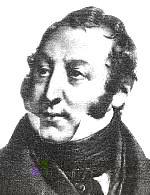

GIOACCHINO ROSSINI (ANTONIE)
29th February 1792 --- 13th November 1868
Copyright 1994-1998 Encyclopaedia Britannica
Last Updated on October 2025
By Steven Ritchie
And now for the Music

(3892)"Siege of Corinth". Sequenced by Steven Ritchie.
"The Barber of Seville". Sequenced by Steven Ritchie.
"William Tell Overture". Sequenced by Steven Ritchie.
"Semiramide Overture". Sequenced by Steven Ritchie.
"Overture To 'Il Tancredi". Sequenced by Steven Ritchie.
Thanks to Takahiro Tamiya for the music below.
NEW (4813)"Sonata No.3, Mov.1". Sequenced by Takahiro Tamiya. NEW (4812)"Sonata No.3, Mov.2". Sequenced by Takahiro Tamiya. NEW (4811)"Sonata No.3, Mov.3". Sequenced by Takahiro Tamiya. Thanks to Dr.Pitt-Payne for the music below.
(3252)"Danse Siberienne, (Siberian dance)". Sequenced by Dr.Pitt-Payne. Thanks to Dr Roger H Sugg for the music below. Email (rhsugg@hotmail.com)
"The Barber of Saville". Sequenced by Dr Roger H Sugg. Thanks to Dereck Riddell for the music below. Email (dereck.riddell@ntlworld.com)
"Domine Deus from Petite Messe Solennelle". Sequenced by Dereck Riddell. Thanks to B.S. Lengton for the music below. Email (mb.lengton@12move.nl)
(2671)"La Danza, An Neopolitan Tarantella". Sequenced by B.S. Lengton. Thanks to George Pollen for the music below. Visit my Bookmark page for his website
(2075)"Overture to Tancredi". Sequenced by George Pollen.
Thanks to Scott P. Anderson for the music below. Email (hi_desert01@hotmail.com)
(1866)"William Tell Overture". Sequenced by Scott P. Anderson. Thanks to Ramon Pajares Box for the music below.
(1542)"L'Italiana in Algeri (1813) Overture". Sequenced by Ramon Pajares Box. (1179)"Count Figaro". Sequenced by Bill King. (177)"La Calunnia e Ventacello,(Info by Cheryl Evans)". Seqenced by Bill King. (246)"Rosina Figaro duet from The Barber of Seville". Sequenced by Bill King. (1181)"Largo al Factotum, from Barbiere di Siviglia". Sequenced by Lft weimermt. (1185)"I Gondolieri". Sequenced by Remi Lucet. (1186)"Signor Bruschino". Sequenced by A. Zammarrelli. (1180)"Overture, La Cenerentola". Sequenced by G.Borello. (1187)"Overture, Italiana in Algeri". Sequenced by G.Borello. (1182)"Aria di Berta, from Barbiere di Siviglia". Sequenced by G.Borello. (1183)"Barber of Seville, Overture". Sequenced by Andrew Parr. (1184)"Overture William Tell". Sequenced by Brian Ames. (411)"Overture from the Barber of Seville". Sequenced by Mark Anthony Williams. (1188)"Overture from Gazza". Sequencer Unknown.
If you done any Classical pieces of say for example, Delius, mozart, and so on etc, please email them to the classical music site with details to "classical (@) ntlworld.com" written this way to stop spammers just remove spaces and brackets for email address, thank you.
Visitors to this page --


Back to Classical Midi Main Menu click "HERE"